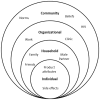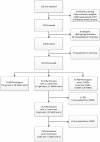Women's experiences with oral and vaginal pre-exposure prophylaxis: the VOICE-C qualitative study in Johannesburg, South Africa
- PMID: 24586534
- PMCID: PMC3931679
- DOI: 10.1371/journal.pone.0089118
Women's experiences with oral and vaginal pre-exposure prophylaxis: the VOICE-C qualitative study in Johannesburg, South Africa
Abstract
Background: In VOICE, a multisite HIV pre-exposure prophylaxis (PrEP) trial, plasma drug levels pointed to widespread product nonuse, despite high adherence estimated by self-reports and clinic product counts. Using a socio-ecological framework (SEF), we explored socio-cultural and contextual factors that influenced participants' experience of daily vaginal gel and oral tablet regimens in VOICE.
Methods: In Johannesburg, a qualitative ancillary study was concurrently conducted among randomly selected VOICE participants assigned to in-depth interviews (n = 41), serial ethnographic interviews (n = 21), or focus group discussions (n = 40). Audiotaped interviews were transcribed, translated, and coded thematically for analysis.
Results: Of the 102 participants, the mean age was 27 years, and 96% had a primary sex partner with whom 43% cohabitated. Few women reported lasting nonuse, which they typically attributed to missed visits, lack of product replenishments, and family-related travel or work. Women acknowledged occasionally skipping or mistiming doses because they forgot, were busy, felt lazy or bored, feared or experienced side effects. However, nearly all knew or heard of other study participants who did not use products daily. Three overarching themes emerged from further analyses: ambivalence toward research, preserving a healthy status, and managing social relationships. These themes highlighted the profound and complex meanings associated with participating in a blinded HIV PrEP trial and taking antiretroviral-based products. The unknown efficacy of products, their connection with HIV infection, challenges with daily regimen given social risks, lack of support-from partners and significant others-and the relationship tradeoffs entailed by using the products appear to discourage adequate product use.
Conclusions: Personal acknowledgment of product nonuse was challenging. This qualitative inquiry highlighted key influences at all SEF levels that shaped women's perceptions of trial participation and experiences with investigational products. Whether these impacted women's behaviors and may have contributed to ineffective trial results warrants further investigation.
Conflict of interest statement
Figures


Similar articles
-
Male Partner Influence on Women's HIV Prevention Trial Participation and Use of Pre-exposure Prophylaxis: the Importance of "Understanding".AIDS Behav. 2015 May;19(5):784-93. doi: 10.1007/s10461-014-0950-5. AIDS Behav. 2015. PMID: 25416076 Free PMC article.
-
Perspectives on use of oral and vaginal antiretrovirals for HIV prevention: the VOICE-C qualitative study in Johannesburg, South Africa.J Int AIDS Soc. 2014 Sep 8;17(3 Suppl 2):19146. doi: 10.7448/IAS.17.3.19146. eCollection 2014. J Int AIDS Soc. 2014. PMID: 25224610 Free PMC article. Clinical Trial.
-
Stated product formulation preferences for HIV pre-exposure prophylaxis among women in the VOICE-D (MTN-003D) study.J Int AIDS Soc. 2016 May 30;19(1):20875. doi: 10.7448/IAS.19.1.20875. eCollection 2016. J Int AIDS Soc. 2016. PMID: 27247202 Free PMC article.
-
Influences on visit retention in clinical trials: insights from qualitative research during the VOICE trial in Johannesburg, South Africa.BMC Womens Health. 2014 Jul 28;14:88. doi: 10.1186/1472-6874-14-88. BMC Womens Health. 2014. PMID: 25065834 Free PMC article.
-
Generating CHARISMA: Development of an Intervention to Help Women Build Agency and Safety in Their Relationships While Using PrEP for HIV Prevention.AIDS Educ Prev. 2019 Oct;31(5):433-451. doi: 10.1521/aeap.2019.31.5.433. AIDS Educ Prev. 2019. PMID: 31550193 Free PMC article. Review.
Cited by
-
Design aspects of vaginal applicators that influence acceptance among target users.Sci Rep. 2021 May 7;11(1):9802. doi: 10.1038/s41598-021-89284-3. Sci Rep. 2021. PMID: 33963262 Free PMC article.
-
Knowledge, Attitudes, and Intentions towards HIV Pre-Exposure Prophylaxis among Nursing Students in Spain.Int J Environ Res Public Health. 2020 Sep 29;17(19):7151. doi: 10.3390/ijerph17197151. Int J Environ Res Public Health. 2020. PMID: 33003632 Free PMC article.
-
Motivations for PrEP-Related Interpersonal Communication Among Women Who Inject Drugs: A Qualitative Egocentric Network Study.Qual Health Res. 2021 Jan;31(1):86-99. doi: 10.1177/1049732320952740. Epub 2020 Sep 1. Qual Health Res. 2021. PMID: 32869694 Free PMC article.
-
Treatment And Prevention for female Sex workers in South Africa: protocol for the TAPS Demonstration Project.BMJ Open. 2016 Sep 26;6(9):e011595. doi: 10.1136/bmjopen-2016-011595. BMJ Open. 2016. PMID: 27678533 Free PMC article.
-
The Influence of PrEP-Related Stigma and Social Support on PrEP-Use Disclosure among Women Who Inject Drugs and Social Network Members.AIDS Behav. 2021 Dec;25(12):3922-3932. doi: 10.1007/s10461-021-03312-x. Epub 2021 May 20. AIDS Behav. 2021. PMID: 34014430 Free PMC article.
References
-
- Thigpen MC, Kebaabetswe PM, Paxton LA, Smith DK, Rose CE, et al... (2012) Antiretroviral Preexposure Prophylaxis for Heterosexual HIV Transmission in Botswana. N Engl J Med doi:10.1056/NEJMoa1110711: 1–12. - PubMed
-
- Choopanya K, Martin M, Suntharasamai P, Sangkum U, Mock PA, et al. (2013) Antiretroviral prophylaxis for HIV infection in injecting drug users in Bangkok, Thailand (the Bangkok Tenofovir Study): a randomised, double-blind, placebo-controlled phase 3 trial. The Lancet 381: 2083–2090. - PubMed
Publication types
MeSH terms
Substances
Grants and funding
LinkOut - more resources
Full Text Sources
Other Literature Sources
Medical
Miscellaneous

